South Pacific e-Postcard #1
from Our French Polynesia Adventures
9/6 to 9/24/2006
La ora na (hello),
We are now almost three weeks into our 101-day South Pacific adventure. During our trip we plan to visit seven countries/protectorates and our 50th state. That includes 16 islands and 24 plane trips (so buy stock in Dramamine!) Presently we are in Tahiti, an island in the French protectorate of French Polynesia. We have already been to the French Polynesian islands of Moorea, Huahine, Raiatea, and Rangiora. If you have never heard of most of these places, we understand. A year ago we were the same situation. So, we thought you might have some questions:
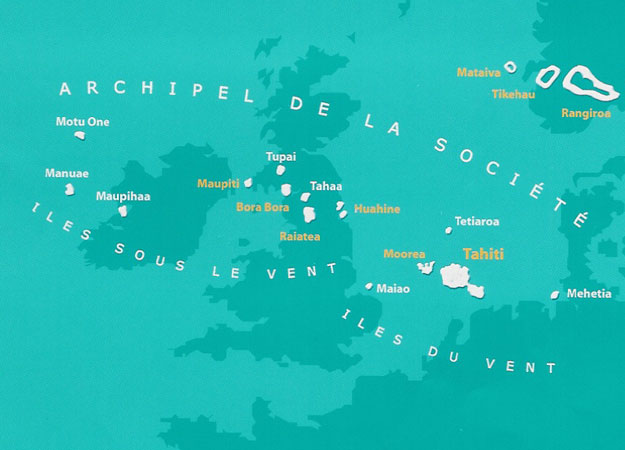
Q: Where is French Polynesia (FP)?
A: Find New Zealand, then trace over 1,200 miles northeast until you see a bunch of tiny specks on your map (usually found in the fold of the page). FP is a county made up of 35 islands and 85 atolls in this general area. The most famous island is Tahiti (isle of love), next is Bora Bora (isle of over-priced resort hotels). There are many other countries besides FP in this general area of the Pacific Ocean. We'll get to some of them later.
Q: What is the geology of FP?
A: FP consists of five archipelagos (groups of islands). Some of the islands were formed by now extinct volcanoes - they have jagged mountains covered in lush vegetation, surrounded in areas by coral reefs. Between the island and the reefs are large areas of shallow water called lagoons. These volcanic islands usually have only a ring road around the island with few interior roads. The other "islands" are actually atolls, where the volcano in the center has worn away over time leaving only the outer ring of coral reefs, now large enough for towns, farms and airports. These coral reefs may be joined by a road but due to the distance between them, usually do not create a complete circle.
Q: What is the weather like?
A: It is a constant 75 - 80 degrees F all year round with the rainy season from November to April for most of the islands. There is always a breeze off the ocean. Some islands have no rainy season. Some call it paradise. I think I would miss the snow!
Q: How about a short history? (I'm sure you are asking this!)
A: The original Polynesians arrived about 150 B.C. from neighboring islands in canoes. Over time they created a highly developed religious and social structure supported by farming and fishing. For enjoyment they did archery, surfing, kite flying, walking on stilts, tobogganing (on vegetation) and canoe racing. They had artistic expression though poetry, drama, song, dance, musical instruments (nasal flutes and drums) and tattooing.
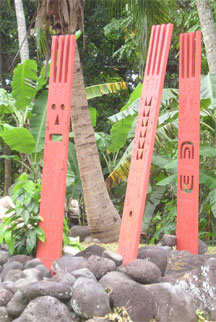
Starting in the 1600s, the Dutch, Spanish, English, and French "discovered" various islands in FP. Captain Cook visited four times starting in 1769. De Bougainville claimed Tahiti for France in 1768 after losing six huge anchors in nine days in the dangerous reef. The infamous Capt. Bligh (of the Bounty Mutiny) stopped here when he was still in control. Later other ships arrived, trading island "goods" like sandalwood, mother of pearl, and slaves for like smallpox, measles, influenza, TB, firearms, and alcohol.
Then came the missionaries (Protestant and Catholic), who converted the natives, virtually destroying all their religious sites (called marea) including a stone pyramid 11 stories high. The success of the missionaries encouraged others to settle in the area, who took over the native lands. A popular folk song about the missionaries sung in FP goes like this:
"When you came, you had the bibles and we had the land.
Now we have the bibles and you have the land."
Q: Why do they call it "French" Polynesia?
A: After subduing the resistance of the island natives and tricking the local chiefs into signing useless treaties (hmm, does that sound familiar?), the French claimed the islands as a protectorate in 1880. Today they make up the majority of the tourists, run the government, the police and the schools. They subsidize local industries including baguettes (see below) and fruit juice production. There is a small native movement for independence but it is difficult to see how FP would survive economically without the F.
Q: What languages do they speak?
A: Parlez-vous francais? Non? Well, French is the official language and taught in all schools. If, like us, your French is minimal and always mispronounced, you will find that many people can speak a little English. Otherwise, we find it helpful to use a dictionary, smile, point, and flash a MasterCard. A couple of important words: Interdit means prohibited, as in don't drive here or do a U-turn if you already did. Arret is stop, alle is go, but they can sound alike when shouted by your snorkel guide.
The native language is Reo Mao'hi, which has five vowels (a, e, i, o, u) and nine consonants (f, h, l, m, n, p, r, t, v). Every word ends with a vowel and (unlike French), every letter is pronounced. So Faa'a International Airport is pronounced Fa-ah-ah. The Vaipoopoo region is pronounced vah-ee-poh-oh-poh-oh. And for the religious site called Marae Taputapuatea in Raiatea we just try to match the letters to the signs. You probably already know some Reo Mao'hi like tabu (forbidden) and ti'i (like tiki stone statues). When you are fed up and don't feel like working you say "fiu" (fee-oo), like our fooey!
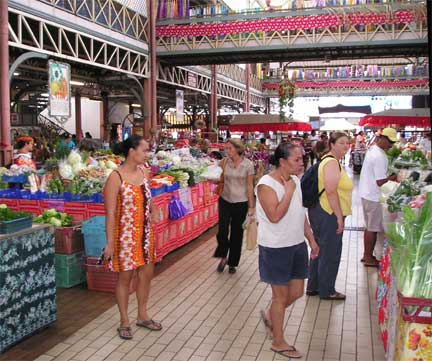
Q: What do people wear?
A: Almost everyone here wears flip-flops (not sandals) as shoes all the time. For men, formal business attire seems to be shorts worn with a short sleeve tropical print shirt, flip flops, and no tie. The guys with the suits are police or foreign pearl merchants. Women wear pareus (long pieces of bright material wrapped in a variety of ways, long skirts or dresses. Young folk wear anything from American logo t-shirts and shorts to short fashionable dresses or surfing attire. The people with the long pants, hiking boots, backpacks, sunhats, sunglasses who smell of sunscreen and bug spray and are looking at maps are us....I mean, tourists!
Q: What about money?
A: Bring lots (although there are ATMs everywhere). The local currency is the CFP (cour de franc Pacifique) or FP franc. One hundred CFP are approximately equal to $1.00 US. So when you look at a can of green beans and it is 204 CFP, which is merely $2.40 a can. No kidding, the stuff here is expensive. However, remember that almost everything must be imported and a lot of it comes from France. The paper money is large and multicolored. The 100 CFP ($1) coins are big, heavy, and frequently used. You never have the right change so these coins seem to multiply like mosquitoes in the rainforest. You never really get over that initial shock of seeing your small bag of groceries costing 2888 CFP, but remember that's under $30!
Q: How's the shopping? Any deals? Any unique products?
A: The best deal is the ubiquitous baguette, the 30+ inch long, thin loaf of French bread you find everywhere. Due to subsidies by the French government, it is only 47 CFP (47 cents) a loaf. It is delivered everywhere everyday. People even have decorated breadboxes next to their mailboxes for home deliveries.
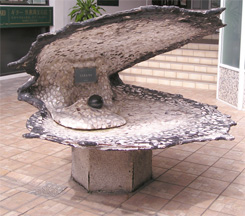
The FP souvenir of choice (for those who can afford it) are black pearls. They actually come in various colors from gunmetal gray to steel blue to green, with an occasional red or gold. The black pearl industry is huge here. There are many opportunities to see pearl farms, where a small spherical piece of shell from a Mississippi River oyster (really!) and a bit of FP oyster shell (to determine color) are implanted in a FP oyster. Two years later, a pearl is removed and the oyster may be implanted again (up to three times). The goal is a large, very smooth, lustrous, perfect sphere - rare indeed. Color does not affect price, only size and perfection do. A very small, good pearl (unset) can be several hundred dollars. A necklace of large perfect pearls would require a second mortgage on your house AND ours put together. But, there are lots of stores and lots of less than perfect pearls and lots of people to tell you that you shouldn't leave the islands without one....or more.
Q: Any special foods/drinks?
A: Well, you can't drink the water so you are constantly at the store buying it. Fortunately, it is cheap ($1 for 1.5 liters) since it is bottled locally. There is some irony in buying locally bottled water because you can't drink the local water. There are also wonderful fruit juices available. We especially like the mango and pamplemousse (grapefruit).
Of course the fish is fresh and varied. We have had swordfish on skewers from a roulette (food trailer), mahi mahi with vanilla sauce, raw fish marinated in coconut milk (called poisson cru - one of Di's favorites) and unknown species grilled on an open fire at a remote motu (very small island in a lagoon). The most surprising fish meal was the fish sandwich with French fries where the fries were IN the sandwich itself!
Due to French influence, most of the grocery stores and restaurants have familiar foods. However, we did learn the hard way that just because something looks like a banana and smells like a banana doesn't mean it is edible. Although Di brought recipes to cook the local vegetables like taro and breadfruit, we will probably wait until we can read the labels in English.
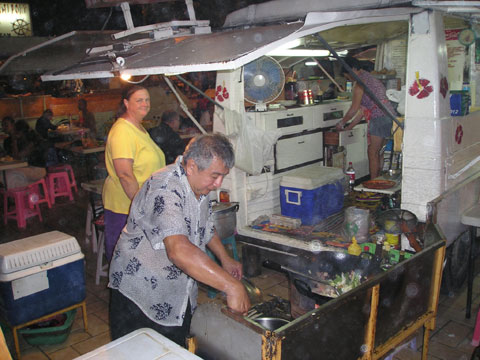
Q: So, what have you two been doing?
A: We thought you'd never ask! Here's a summary, in order of visitation.
Tahiti: We arrived in Papeete, Tahiti (capitol of FP) after a 9-hour layover in LA. Our pension (small, private rooming house) was located about 700 meters (under a half mile) from downtown. Since people can park anywhere they wish for free, it was a short but dangerous walk. Often we would have to walk in the busy street because the sidewalks were full of parked cars. Papeete is a typical tourist town, teeming with people when the cruise ships come in and packed with souvenir shops and pearl stores. Long walks around town helped us to find grocery stores for lunches (baguettes, cheese, and Coke), a nice park, and some local sights. The open-air market was a bustle of merchants selling everything from fresh fish and vegetables to cosmetics to tablecloths to unidentifiable but wonderfully exotic-smelling spices. Dinner was on the waterfront at the various roulettes (food trailers). We only spent two nights in Papeete, as we would return to Tahiti later.
Moorea: A very short ferry ride took us to Moorea (isle of mystery), easily seen from Papeete. The mist-covered sharp pointed mountains did give the island an exotic feel. We took local transportation to our bungalow. What a hoot! Imagine a well-worn bus, all windows open (no A/C), packed with people. Well, not just people, actually. Since Moorea is small, many folks go to Tahiti to bring back those special items. Our bus also had a balloon bouquet (took up two seats), a single mattress (took up part of the aisle), several large packages of disposable diapers, and a very large, beautifully decorated cake (which was held up over peoples heads as passengers left). You would pull a cord or yell out to make the bus stop. This is the most entertainment we've had for $3 in a long time.
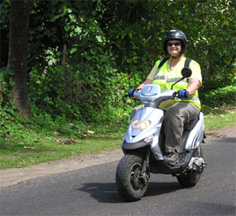
In Moorea we stayed in a high class (for us) resort. We had a private bungalow with a kitchen, close to the ocean. For those of you who have read about our past travels, we tend to stay in budget (cheap) hostels where we can cook our own meals and hope for a private bathroom. Here, the privacy was a luxury. We swam and snorkeled at the resort beach. One day we took pirogues (small canoe with an outrigger) to a private motu to snorkel. Another day we rented small mopeds (scooters) and circled the island, stopping to walk to waterfalls, eat, hunt out the belvederes (high scenic views), and visit maraes (religious sites). With very little traffic, this was a great way to travel. Di, who had never driven her own motorcycle before, had no trouble navigating the unimproved roads. She even reached the dizzying speed of 40 mph!
Huahine: Next, we flew to the sister islands of Huahine-Nui (big) and Huahine-Iti (small). These volcanic islands are joined by a man-made bridge, so the circle road around them forms a figure eight. We stayed right on the wharf-front in a room more "budget" than the last. The bathroom ranked in the top (or is it bottom) 10 smallest we have ever seen. But we were on the main drag (actually, there are only two streets in the main town of Fare). The biggest surprise was the grocery store in this little town. Due to the popularity of Huahine with yachters, the store made the international aisle of Meijers look downright provincial. You name it, they had it....ingredients to make Italian, French, Chinese, Japanese, even Mexican meals.
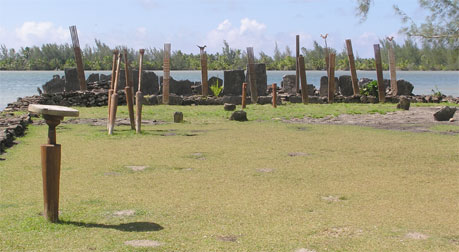
We rented bicycles to see the nearby maraes. A marae is a place where native religious ceremonies were held. They consist of stone platforms of various sizes, some having raised "altars" and/or tall stones to serve as backrests for the chiefs and religious leaders. There were maraes for each family, some for specific occupations like fishermen or warriors, and maraes for the region, island, or island group. Maraes can be found all over the South Pacific. Huahine is known for several famous ones, including a huge structure built of hand-rounded basalt rocks. Most of the maraes were destroyed or neglected after the conversion of the islands to Christianity, but there has been a drive to re-discover and restore, if possible, these important cultural sites.
The maraes were great but the road to them was being freshly blacktopped. As a result, both of us have a permanent streak of tar spots up our pants. Well, we've never been accused of being fashionable tourists, so we'll just chalk (or tar) this one up to experience.
A scooter trip around the islands led to more maraes (and no new tar), more wonderful views, a visit to a mid-lagoon pearl farm, and a chance to see the feeding of the four-foot long blue-eyed eels. These eels live in one of the island rivers and were thought (in local legend) to have brought fresh water to the area.
A boat trip around the islands allowed us to snorkel the reefs, seeing colorful fish and coral.
We expect to hear of strange customs as we travel, but Huahine had one of the weirdest. If you and your neighbors bet against another group on the outcome of a soccer game and lose, the winners burn down the vegetation on your mountainside! I would think having to buy a round of drinks would be preferable.
Raiatea: This island is the second largest in FP and considered the "sacred isle". We chose Raiatea to see the most famous of the maraes. This may sound strange, but for us, visiting a variety of maraes is like visiting the great cathedrals of Europe or the stone circles of the British Isles. It gives us a sense of the cultures of each of the places we see. This time we chose to take a guided tour with Bill, a former Hawaiian resident.
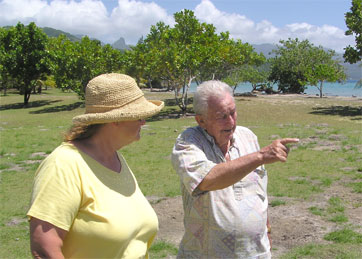 He speaks seven languages, has two PhDs, has lived on Raiatea for 27 years and is 85 years old! He drove us around (very slowly) to the maraes, explaining the history and religion of Polynesia. His insights helped us to put many things we had seen in perspective...this was an extremely valuable tour for us. Bill also gave us insights into the current politics and society.
He speaks seven languages, has two PhDs, has lived on Raiatea for 27 years and is 85 years old! He drove us around (very slowly) to the maraes, explaining the history and religion of Polynesia. His insights helped us to put many things we had seen in perspective...this was an extremely valuable tour for us. Bill also gave us insights into the current politics and society.
For example, a local politician ran for office and was defeated. When he next ran, he won but couldn't forgive the people for his first loss. He built a road in front of the oceanfront houses so they were no longer oceanfront! This is locally known as the "Spite Highway".
FP is known for its laid-back atmosphere. Things run on "island time" which means, "when I get to it". Bill showed us a fire station now infamous for being too laid back. The firemen decided not much was happening, so they all left the station and went to a party. While they were gone, a fire started close to the station. By the time they returned, the entire neighborhood had burned down! When we passed the station in the late morning, no one was stirring. There had been a very late party the night before (at the station this time) and all the guys were still sleeping it off.
Rangiroa: As you fly into Rangiroa, you notice the lack of a real island...this is our first atoll. The ring of coral deposits surround a lagoon so large, the island of Tahiti would fit into it. Our goal here was to snorkel the Tipua Pass, where a strong current rushes in from the ocean to the lagoon. Rush is the word! Led by our snorkel guide, the six of us in our group just formed a line by holding hands and let the current take us through the pass. In the clear 30 meter deep water below us saw schools of fish, sea turtles, barracuda, and reef sharks. Later we snorkeled individually among the coral, a "natural aquarium". This is one of the most interesting snorkeling experiences we've ever had.
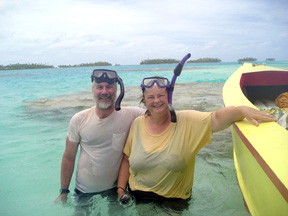
The next day we braved three-foot waves in a small tour boat to go to the "Blue Lagoon" (a lagoon within the Rangiroa lagoon). Landing on a motu (small island), we snorkeled (see attachment), ate native dishes, watch our guides weave baskets from palm leaves and listed to island music. The on-land part was wonderful. The boat part was not. The small motor boat held about 10 people and had no life preservers. We knew we were in for an "adventure" when the boat owners started tying ropes around the seats for us to hold onto and handing out rain slickers. One hour (one way) of constant sprays, big waves, and prayer. Then we knew we had to return the same way. We'd recommend this trip, but ONLY on a calm day.
Tahiti: At this point we are back in Tahiti, visiting the rest of this lovely island for a few days. It is our chance to eat our last baguette, mispronounce our last French, and use up our francs before heading to the Cook Islands, a protectorate of New Zealand.
As internet service is extremely slow (when you can find it), you may not hear from us until we get to New Zealand. In the meantime, take care of yourselves. Mau ruu ru (thanks) for reading and au revoir.
Di & Tim
 He speaks seven languages, has two PhDs, has lived on Raiatea for 27 years and is 85 years old! He drove us around (very slowly) to the maraes, explaining the history and religion of Polynesia. His insights helped us to put many things we had seen in perspective...this was an extremely valuable tour for us. Bill also gave us insights into the current politics and society.
He speaks seven languages, has two PhDs, has lived on Raiatea for 27 years and is 85 years old! He drove us around (very slowly) to the maraes, explaining the history and religion of Polynesia. His insights helped us to put many things we had seen in perspective...this was an extremely valuable tour for us. Bill also gave us insights into the current politics and society.







